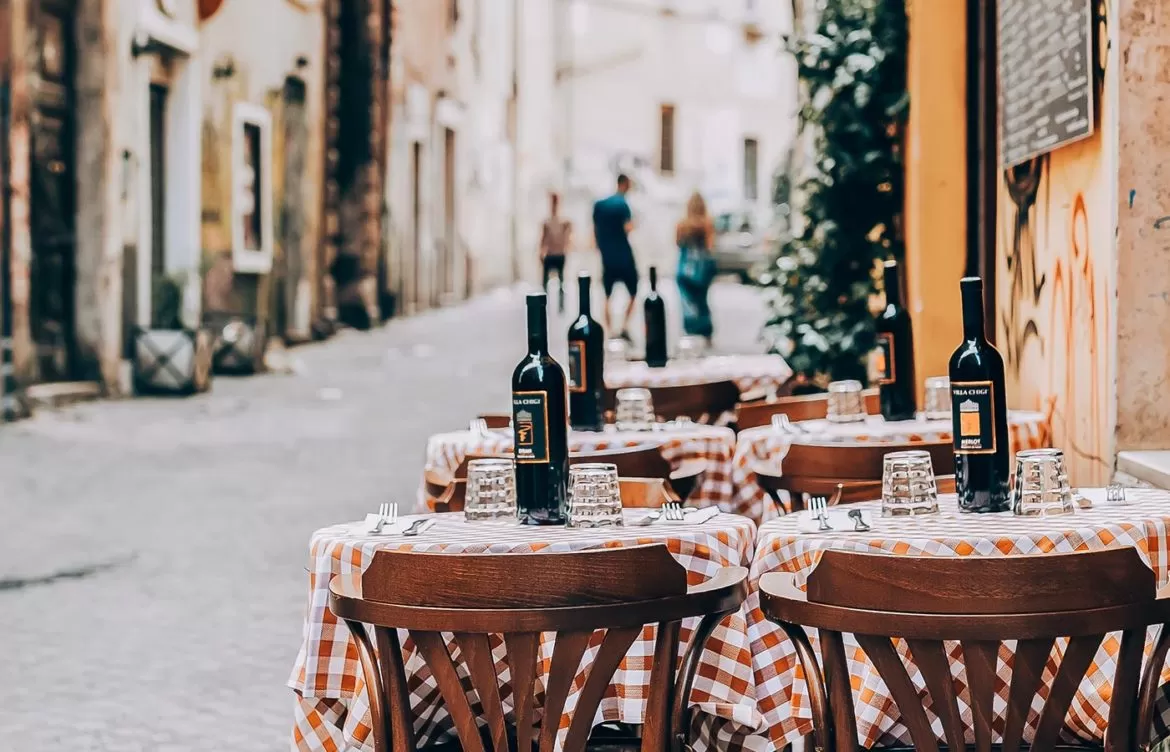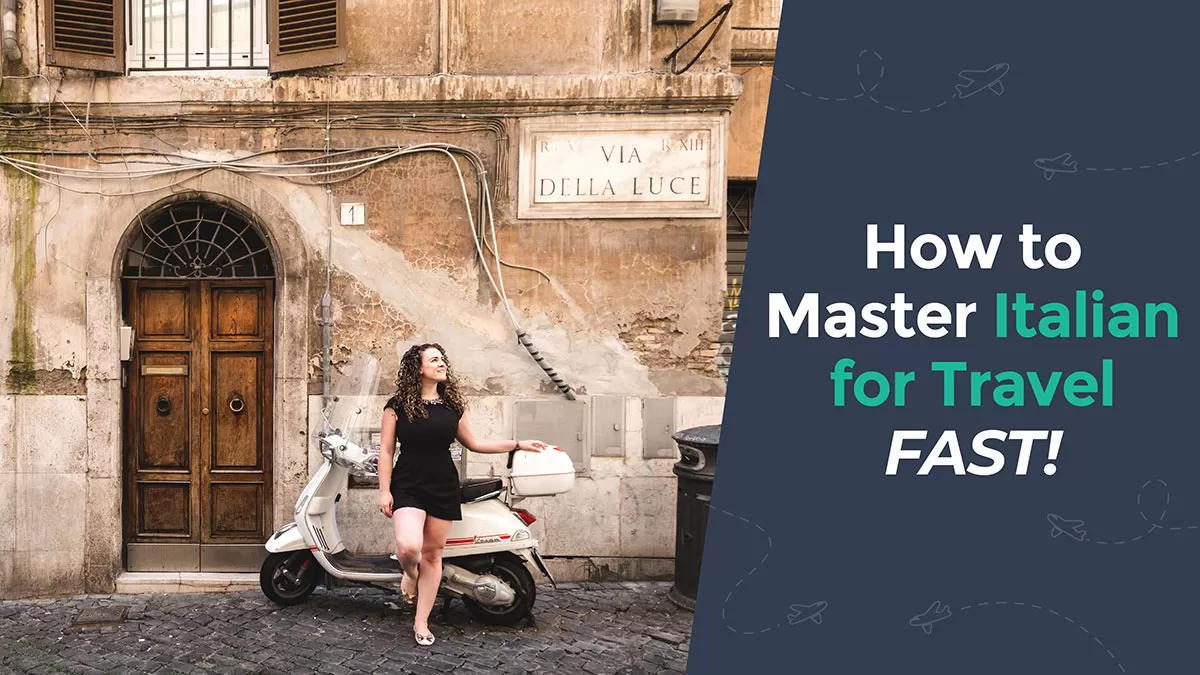Whether you’re visiting Italy for a dream holiday or you’re planning to move to il bel paese (literally, ‘the beautiful country’), knowing how to order food in Italian is essential. Impress the locals with your Italian skills with this handy guide to learning Italian for beginners.
One of the best ways to explore Italian culture is to sample its incredible cuisine. Imagine how meaningful and rewarding your travel experiences will be when you can greet locals in Italian and then confidently order your morning coffee and croissant, or pizza for dinner? Learning a few key Italian travel phrases will make all the difference to your experience in Italy. Keep this guide on common Italian vocabulary up your sleeve and you’ll have no problems being understood. Buon appetito! (bwohn ahp-peh-tee-toh)! (Enjoy your meal!)
Italian meals (Pasti italiani)
Italians eat three meals a day: la (prima) colazione (lah pree-mah koh-lah-tyoh-neh) (breakfast), il pranzo (eel prahn-zoh) (lunch), and la cena (lah cheh-nah) (dinner).
For Italians, il pranzo (eel prahn-zoh) (lunch) is the most important meal of the day. In some parts of Italy, especially in the south, Italians will go home and have a long lunch with their family before returning to work in the late afternoon.
Dinner time varies around the country; for example, restaurants in Venice stop serving dinner much earlier than those in Rome, where you can still go out to eat as late as 9 p.m. or 10 p.m.
In the café (Al Bar)
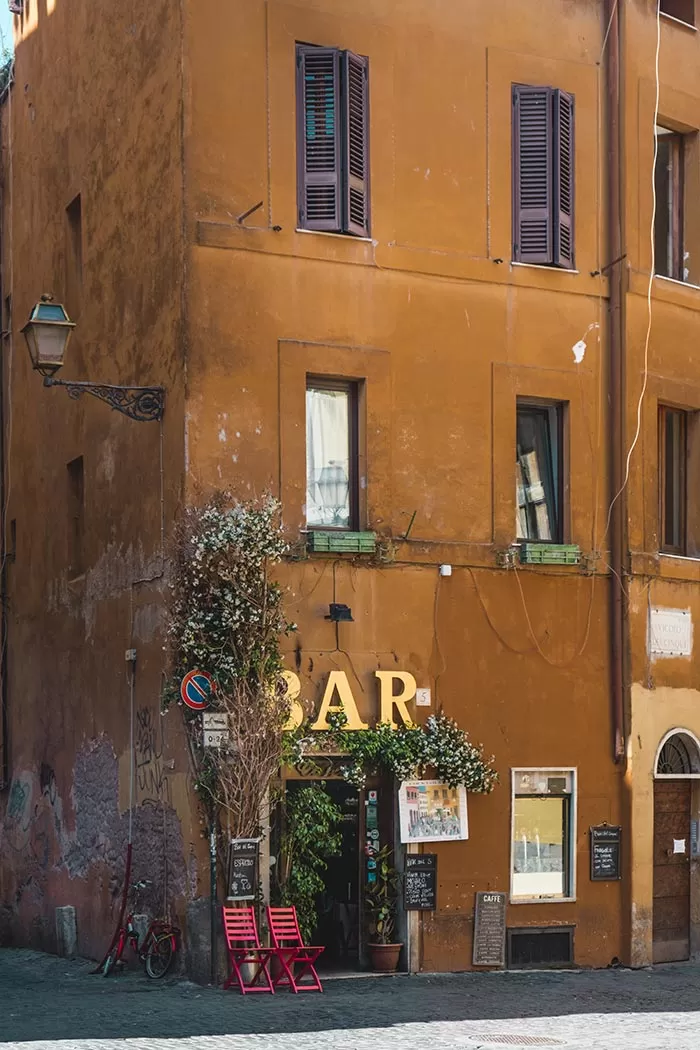
What do Italians eat for breakfast? For the most part, Italians start their day either by having breakfast a casa (a kah-zah) (at home) or al bar (al bahr) (in the café). The Italian bar is what the English-speaking world calls a café.
Italians usually order un caffè e un cornetto (oon kaffay eh oon kor-neht-toh) (coffee and a croissant) for breakfast and stop by later in the afternoon for un panino (oon pah-nee-no) (a sandwich) or a salty snack before enjoying a before-dinner drink with friends. This is called un aperitivo (ah peh-reh-tee-voh).
Italian croissants come in five variations, they can be semplice (sehm-plee-cheh) (plain), salata (sah-lah-tah) (savory), filled with marmellata (mahr-mehl-lah-tah) (jam), crema (kreh-mah) (custard), or cioccolato (chohk-koh-lah-toh) (chocolate).
Drinking coffee is a way of life in Italy and has its own culture that is different from what you’re probably used to. When you ask the barista (bah-rees-tah) or il cameriere (eel kah-meh-ryeh-reh) (the waiter) for un caffè (oon kahf-feh) (a coffee) you’ll get an espresso – this is Italy’s preferred and most popular way to enjoy coffee.
How to order Italian Coffee (Come ordinare il caffè italiano)
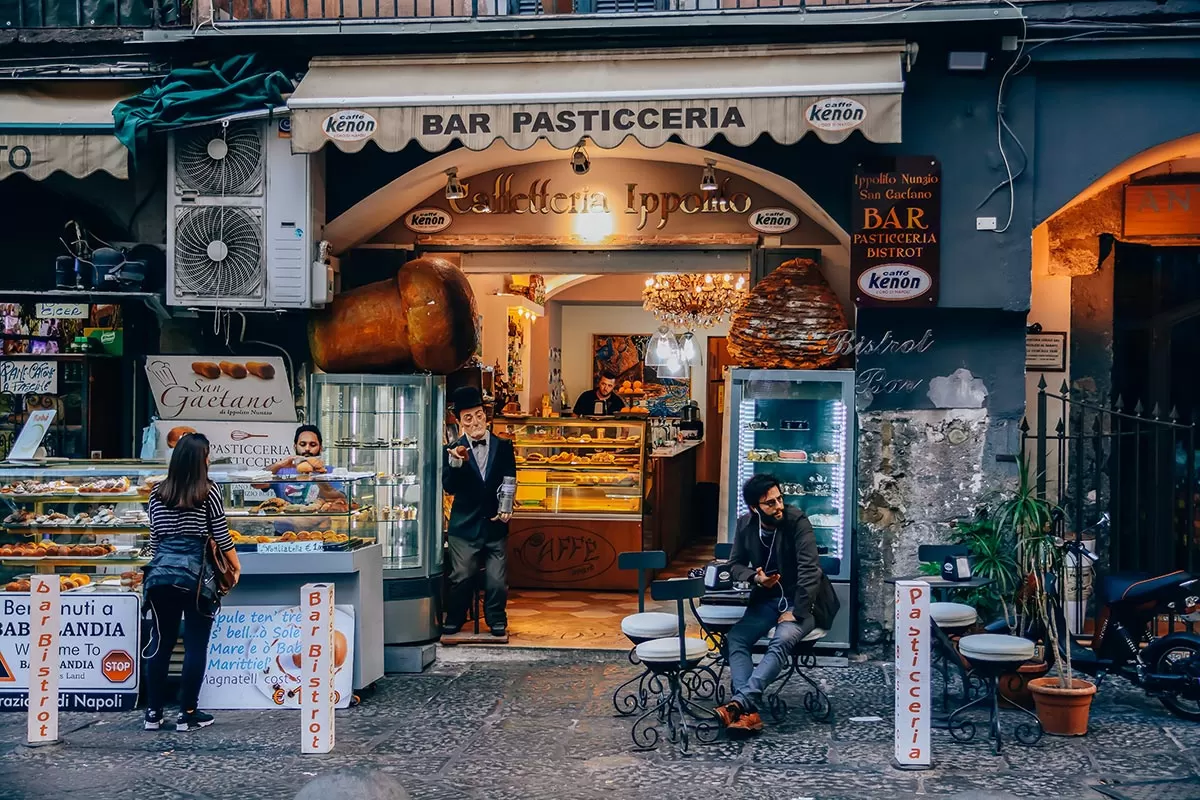 Not sure what your favourite coffee is called in Italian? Below is a list of common coffee terms to keep in mind when ordering your coffee al bar.
Not sure what your favourite coffee is called in Italian? Below is a list of common coffee terms to keep in mind when ordering your coffee al bar.
- un Caffè Hag (oon kahf-feh ahg): A super popular brand of instant decaffeinated coffee
- un caffè (kahf-feh): When you order un caffè, you automatically get an espresso.
- un caffè ristretto (ree-streht-toh): Very strong and concentrated espresso.
- un caffè doppio (dohp-pyoh): Double espresso.
- un caffè lungo (loon-goh): Espresso with more water to make it less concentrated.
- un caffè corretto (kohr-reht-toh): Espresso with a bit of cognac or other liquor.
- un cappuccino (kahp-pooh-chee-noh): Espresso with frothed milk.
- un caffelatte (kahf-feh-laht-teh): Espresso with plenty of milk.
- un caffè macchiato (mahk-kyah-toh): Espresso with a dash of milk.
- un latte macchiato (laht-teh mahk-kyah-toh): Hot milk with just a dash of espresso.
- un caffè americano (kahf-feh ah-meh-reekah-noh): A strong American-style coffee
- un caffè decaffeinato (deh-kahf-feh-eenah-toh): Decaffeinated coffee.
- un caffè d’orzo (kahf-feh dohr-zoh): A espresso-style caffeine-free roasted grain beverage made from ground barley. You can have it strong or light.
- caffè freddo/shakerato (kahf-feh frehd-doh/sheh-keh-rah-toh): Iced coffee
Tips for ordering drinks in Italy
- Coffee doesn’t come in various portion sizes, it’s a one size fits all system.
- Italians mostly drink their coffee while standing at the bar. If you want to sit down, the price will be higher. The concept of coffee ‘to go’ or ‘takeaway’ is one used primarily by tourists.
- Italians don’t drink milk anytime after breakfast, this includes cappuccino. It’s considered a faux pas to order a cappuccino anytime after 11 a.m.
- Ordering a latte is precisely just that — milk, and not a caffe latte. To order a glass of warm milk, say un bicchiere di latte tiepido (oon bee-kyeh-reh dee laht-teh tyeh-pee-doh).
- Italians are not big tea drinkers. They generally only drink it before going to bed or when sick). Instead of milk, they will add some lemon. So, if you want milk in your tea, you may have to ask for un po’ di latte freddo (oon po dee lat-teh fred-doh) (a little bit of cold milk).
- Tipping for coffee in Italy is not expected nor standard. Mind you that if you sit down for coffee, you may be charged a service fee for the servizio al tavolo (table service), especially in touristy areas. In this particular situation, tipping is not necessary. Learn more about tipping in Italy with my guide.
If you’re not a big coffee drinker, you can also order:
- cioccolata calda (chohk-kohlah-tah kahl-dah) – hot chocolate
- tè (teh) – tea
- tè freddo (teh frehd-doh) – iced tea
- la tisana (lah tee-za-nah) – herbal tea
- camomilla (kah-moh-mee-lah) – chamomile tea
- succo di frutta (soohk-koh dee frooht-tah) – fruit juice
- spremute (spreh-mooh-teh) – fresh-squeezed fruit juice
- spremuta d’arancia (spreh-mooh-tah dah-raan-chah) – fresh-squeezed orange juice
- acqua (ah-kwah) – water
- acqua minerale (ah-kwah mee-neh-rah-leh) – mineral water
- acqua gassata/gasata (ah-kwah gas-sah-tah/gah-zah-tah) – sparkling water
- acqua frizzante (ah-kwah freez-zahn-teh) – sparkling water
- acqua liscia or acqua naturale (ah-kwah lee-shah or ah-kwah nah-tooh-rah-leh) – still water
In estate (ehs-tah-teh) (summer), you may also want to your drink con ghiaccio (kon gyahch-choh) (with ice).
When you order a drink in Italy, you may want to specify how much you would like using the following phrases:
- un bicchiere di… (oon beek-kyeh-reh dee) – A glass of …
- una bottiglia di… (ooh-nah boht-tee-lyah dee) – A bottle of …
- una caraffa di… (ooh-nah kah-rahf-fah dee) – A carafe of …
- un mezzo litro di… (mehdz-oh lee-troh dee) – half a litre of …
The last two terms are generally used when you order house wine which is vino della casa (vee-no del-lah kah-zah) or a birra (beer-rah) (beer).
Celebrating something or just catching up with friends? Learn how to say ‘cheers’ in Italian and 6 rules of etiquette to avoid making a faux pas.
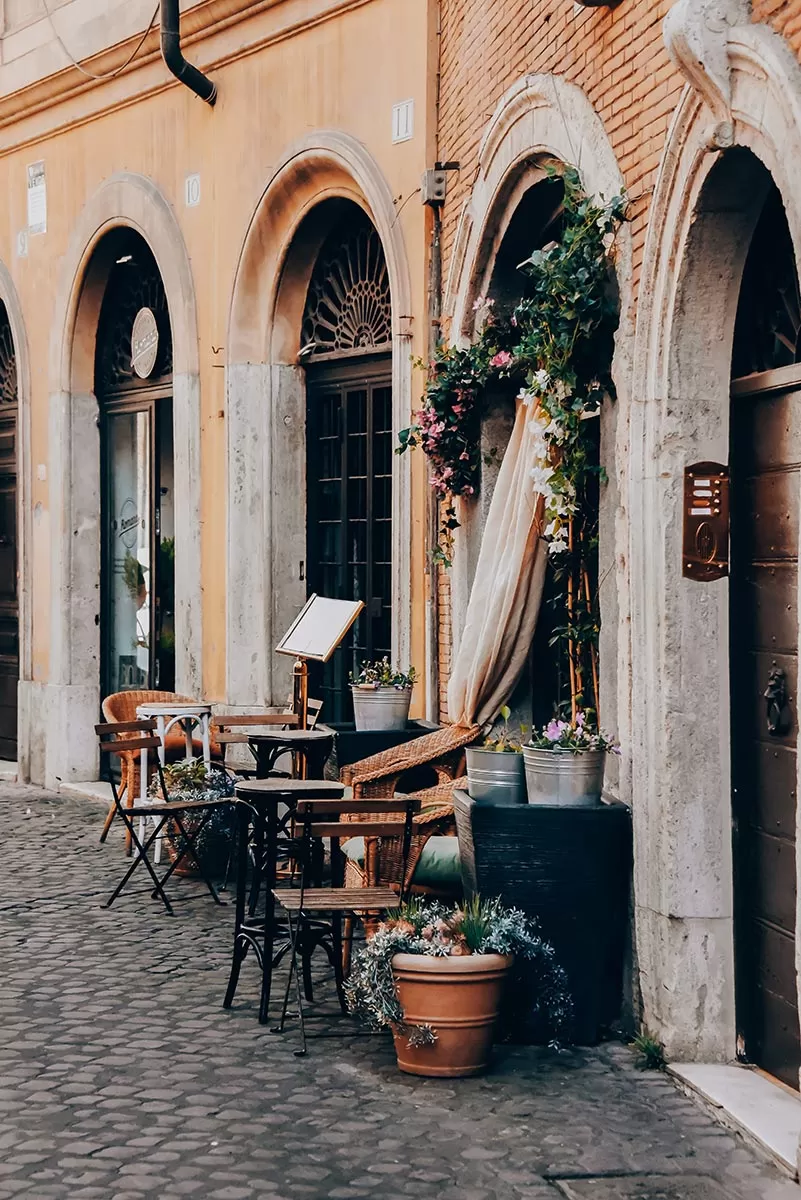 When do you pay? (Quando si paga?)
When do you pay? (Quando si paga?)
When you go to an Italian bar it can be tricky to know when you need to pay. As a general rule of thumb, in small Italian bars where just a couple of people work behind the bar, you generally order at the bar first then tell the cashier afterwards what you had then pay.
In larger bars, that attract more customers, you generally first pay at the cassa (kas-sah) (cash register), get a receipt called a scontrino (skohn-tree-noh), and take the receipt over to the barista to place your order.
How to order breakfast al bar
To feel like a local during your trip to Italy, I highly recommend going to the same bar each morning. This way il barista (eel bah-rees-tah) (the barman) will get to know you and engage in conversation. Below is a short, but common exchange of dialogue you’re likely to encounter when placing an order at your local bar.
Barista:
Buongiorno!
(bwohn-johr-noh)
Good morning!
You:
Un caffè e un cornetto semplice, per favore.
(bwohn-johr-noh oon kahf-feh eh oon kor-neh-toh sehm-plee-cheh, pehr fah-voh-reh)
Good morning! One espresso and a plain croissant, please.
Barista:
Certo! Qualcos’altro?
(cherh-toh, qwahl-kohs-ahl-troh)
Certainly! Anything else?
You:
No, grazie. Nient’altro
(noh, grah-zyeh nyent-al-troh)
No thank you, nothing else.
Barista:
Ecco il caffe e il cornetto. Prego.
(ehk-koh eel kahf-feh eh eel kor-neh-toh, preh-goh)
Here’s the coffee and croissant. Here you go.
In the restaurant (Al Ristorante)
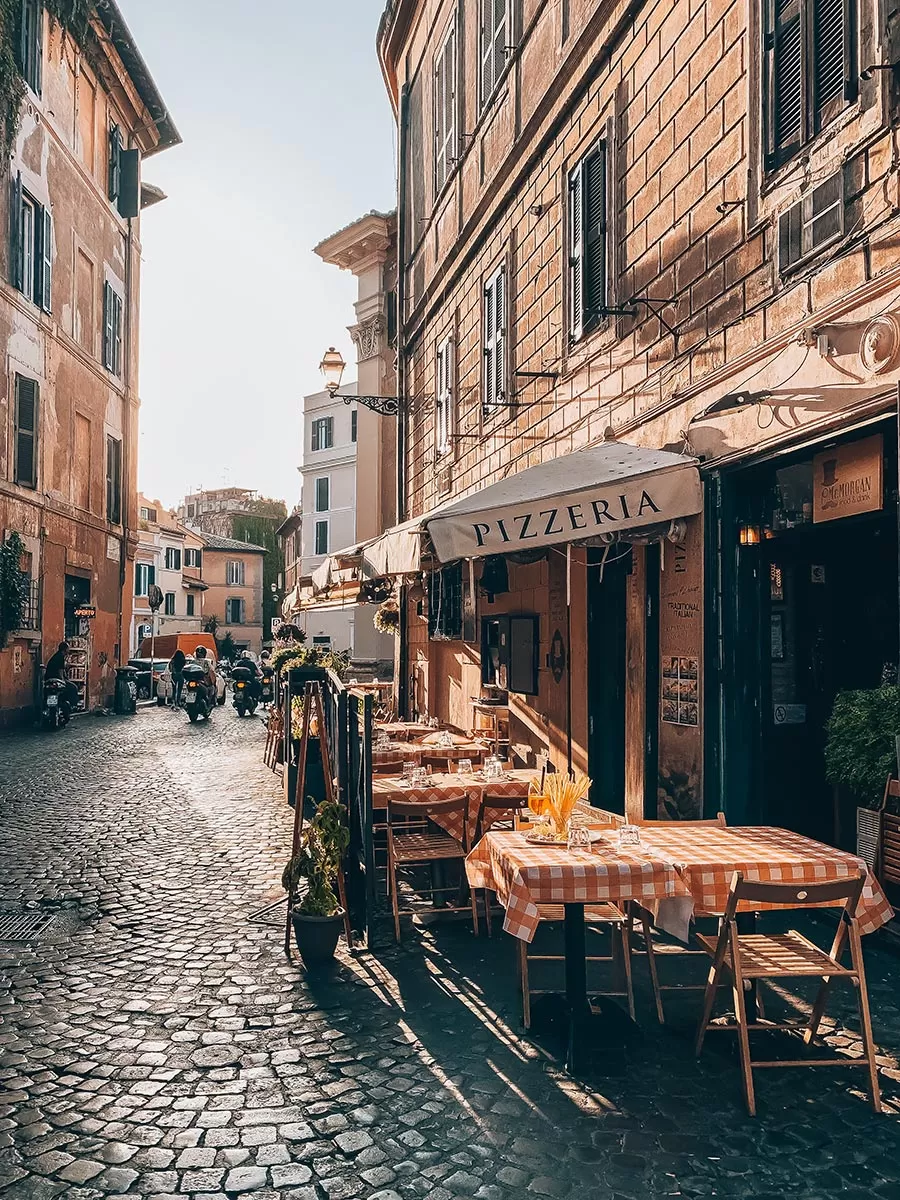 In Italy, there are various types of eating establishments to choose from each with a unique dining experience. Below is a list of the most common eateries you’ll come across in your travels.
In Italy, there are various types of eating establishments to choose from each with a unique dining experience. Below is a list of the most common eateries you’ll come across in your travels.
- Osteria (os-te-ree-ah) – A moderately priced restaurant with a short menu of simple foods like pasta, grilled meat, and wine
- Trattoria (tra-tor-ree-ah) – A step up from the osteria, typically family-run, typically specialising in rustic home-cooked foods
- Ristorante (ris-tor-rahn-teh) – A higher-end full-service dining establishment
- Enoteca (eh-no-teh-kah) – A wine bar, sometimes also serving small plates
- Pizzeria (peez-zah-ree-ah) – Specialising in pizza, they are a relaxed and cheap way of dining out and are ideal for big groups.
Both lunch and dinner usually consist of several courses. These include:
- un antipasto (oon ahn-tee-pahs-toh) (an appetizer): Usually served hot and cold, antipasti vary from region to region.
- il primo piatto (eel pree-moh pyaht-toh) (the first course): The primo is when you eat your pasta (pahs-tah) (pasta), risotto (ree-zoht-toh) (risotto), or minestra (mee-nehs-trah) (soup).
- il secondo (eel seh-kohn-doh) (the second course): This is when either carne (kahr-neh) (meat) or pesce (peh-sheh) (fish) is served and is prepared in a wide variety of ways.
- i contorni (kohn-tohr-nee) (side dishes): the second course doesn’t come with anything other than the meat or fish, so vegetables need to be ordered separately.
- il dolce (eel dohl-cheh) (the dessert): Dessert can be un dolce (oon dohl-cheh) (a sweet), frutta fresca (froot-tah frehs-kah) (fresh fruit), or una macedonia (ooh-nah mahcheh-doh-nee-ah) (fruit salad).
Ordering food with prendere and volere
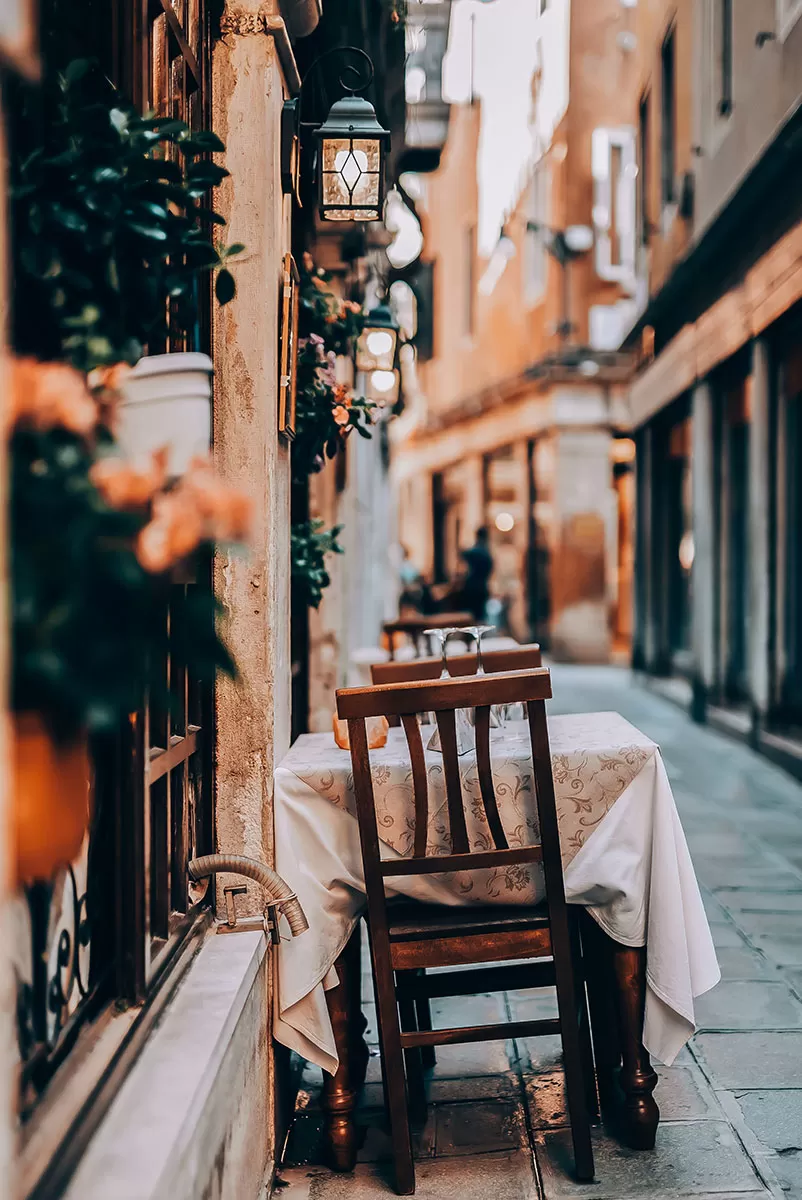 When ordering food in Italian, the verb you should use is prendere (prehn-deh-reh) which literally means to take, but here, it means to have. Use the conjugated form of prendere whenever you order food or drinks.
When ordering food in Italian, the verb you should use is prendere (prehn-deh-reh) which literally means to take, but here, it means to have. Use the conjugated form of prendere whenever you order food or drinks.
Whenever you speak, you change verbs to reflect the subject of the verb specifying who is doing the action. This process of changing verbs is called conjugating. For example, if you say ‘She’ll have a pizza’, then she is the subject. She is the person conducting the action.
Below is how to conjugate the verb prendere (to take, to have) in the present tense.
- io prendo (ee-oh prehn-doh) – I take/have
- tu prendi (tooh prehn-dee) – you take/have (informal)
- Lei prende (ley prehn-deh) – you take/have (formal)
- lui/lei prende (looh-ee/ley prehn-deh) – he/she takes/has
- noi prendiamo (noi prehn-dee-ah-moh) – we take/have
- voi prendete (voi prehn-deh-teh) – you take/have (plural)
- loro prendono (loh-roh prehn-doh-noh) – they take/have
In English, there are three different ways to express the present tense:
- The simple present: ‘I eat’
- The present progressive: ‘I am eating’
- The emphatic present: ‘I do eat’
In Italian, we can express all three of these meanings just by saying prendo (prehn-doh) (I take/have, I’m taking/having, I do take/have). It can also be used to express the future, for example, I’ll have.
Another verb you can use when ordering food is volere (voh-leh-reh) (to want). To express politeness when ordering food, Italians will use the conditional tense of volere which means would like.
Below is how to conjugate the verb volere (voh-leh-reh) (to want) using the conditional tense.
- io vorrei (ee-oh vohr-ray) – I would like
- tu vorresti (too vohr-rehs-tee) – you would like (informal)
- Lei vorrebbe (ley vohr-rehb-beh) – you would like (formal)
- lui/lei vorrebbe (loo-ee/ley vohr-rehb-beh) – he/she would like
- noi vorremmo (noi vohr-rehm-moh) – we would like
- voi vorreste (voi vohr-rehs-teh) – You would like (plural)
- loro vorrebbero (loh-roh vohr-rehb-beh-roh) – they would like
Related: How to Conjugate Italian Verbs in 3 Simple Steps [Italian for Beginners]
How to order al ristorante
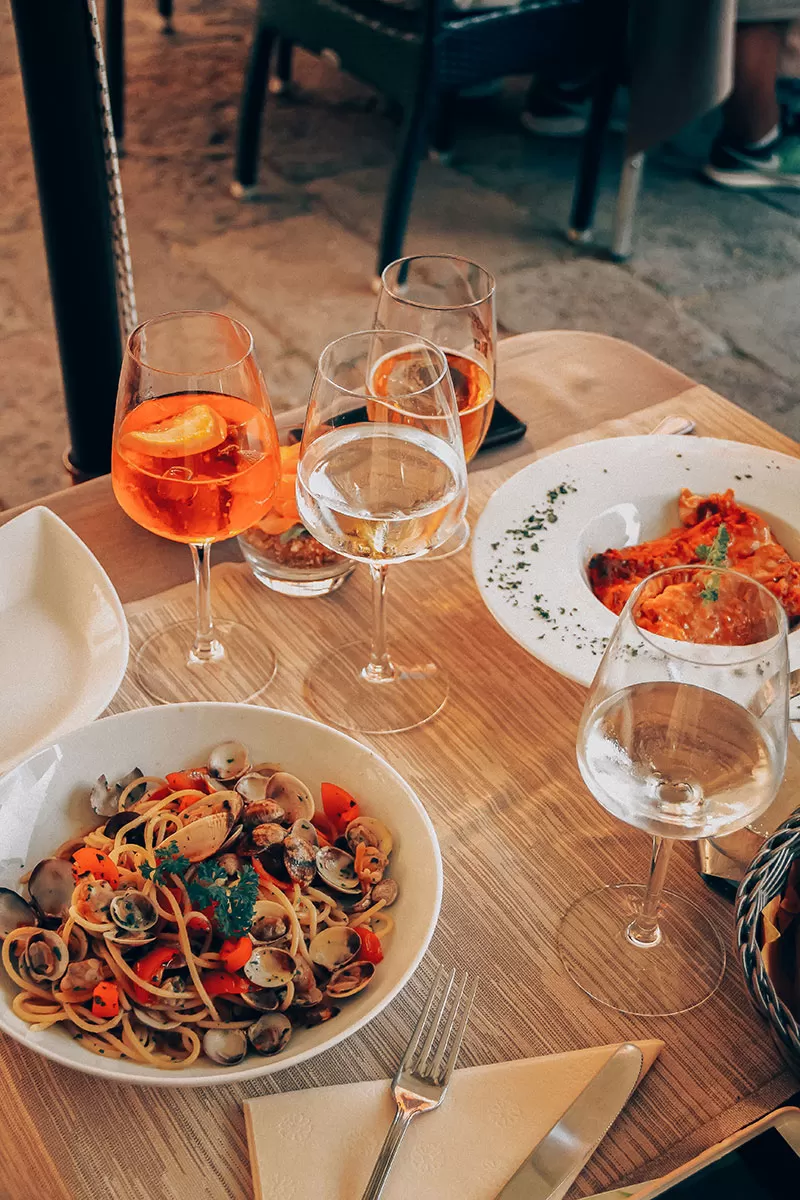 Below is a short dialogue with you and a friend dining out which uses common Italian phrases and vocabulary you’ll need when ordering food in Italian. For more, check out my guide on how to ask questions in Italian.
Below is a short dialogue with you and a friend dining out which uses common Italian phrases and vocabulary you’ll need when ordering food in Italian. For more, check out my guide on how to ask questions in Italian.
Waiter: Buonasera. Quanti siete? – Good evening. How many are you?
You: Buonasera. Due, per favore. – Good evening. Two, please.
Waiter: Va bene. Prego. – OK. Come with me.
Waiter: Pronti? Che cosa volete? – Ready? What would you like?
You: Sono vegetariana. Che cosa consiglia? – I’m vegetarian. What do you recommend?
Waiter: La pizza margherita è buonissima. – The margherita pizza is delicious
You: Va bene. Prendo la pizza margherita, per favore. – OK, I’ll have the pizza margherita, please.
Waiter: Certo. E Lei? Cosa prende? – Certainly. And you? What would you like?
Your friend: Prendo la bistecca e una insalata mista. Vorrei la bistecca cotta al punto giusto. – I’ll have the steak and mixed salad. I would like my steak medium.
Waiter: Perfetto. Qualcosa da bere? – Perfect. Something to drink?
Your friend: Una bottiglia di vino rosso e una bottiglia di acqua gassata, per favore. – A bottle of red wine and a bottle of sparkling water, please.
Waiter: Perfetto. Torno presto. – Perfect. I’ll be back soon.
Waiter: Eccoci! Buon appetito! – Here we are! Enjoy your meal!
You: Grazie! – Thank you!
Waiter: Va bene tutto? – Everything ok?
Your friend: Sí! Era buonissimo! Il conto, per favore – Yes! It was delicious….The bill. please.
Waiter: Certo! Eccolo – Certainly! Here it is.
Your friend: Posso pagare con carta di credito? – May I pay by credit card?
Waiter: Sí!….Ecco lo scontrino – Yes!….Here is your receipt.
Your friend: Grazie mille. ArrivederLa! – Thank you. Goodbye!
Waiter: Prego. ArrivederLa! – You’re welcome. Goodbye!
Prego? vs. Prego! – The many meanings of ‘prego’
Prego (preh-goh) is one of the most usual and versatile words in the Italian language. It carries several meanings, all of which depend on the context in which it’s used.
You can say prego in response to grazie (grah-zyeh) (thank you), which means ‘you’re welcome.’ Shop assistants and servers say prego to ask what you would like or if they can help you. You’ll often hear Prego? when you enter a store.
You can also use prego when you give something to someone. In this context, it means ‘here you go’ or ‘here you are.’
Prego is also a very formal reply when asking for permission. Below are a few examples of how prego is used:
- Grazie. (grah-zyeh) (Thank you.) → Prego. (preh-goh) (You’re welcome.)
- Prego? (preh-goh) (Can I help you?)
- Posso entrare? (pohs-soh ehn-trah-reh) (May I come in?)
- Prego. (preh-goh) (Please.)
- Prego, signore. (preh-goh see-nyoh-reh) (Here you are, sir.) → Grazie. (grah-zyeh) (Thank you.)
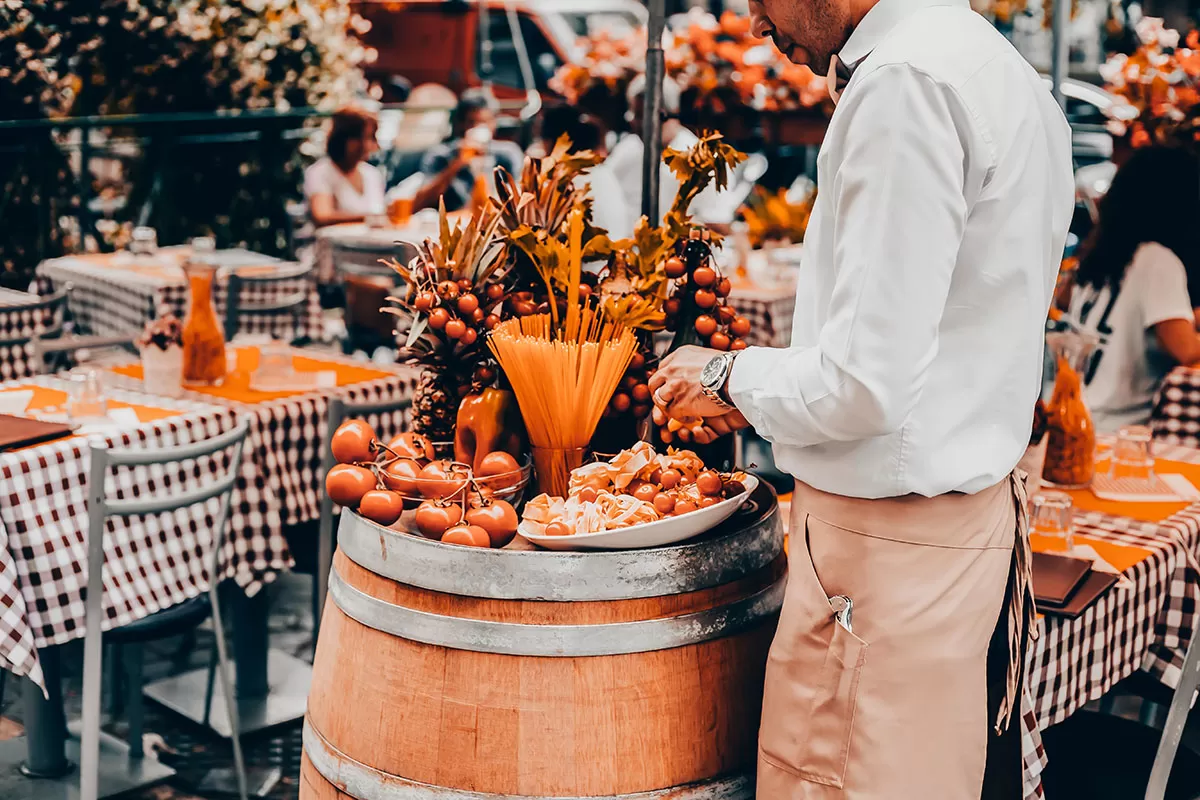 Other Useful Italian phrases
Other Useful Italian phrases
Below is a list of other useful Italian phrases you may hear or want to use.
- Avete una prenotazione? (ah-ve-teh oo-na pre-no-tah-zyee-oh-nay) – Do you have a reservation?
- No, non abbiamo prenotato (noh, non ab-bya-mo pre-no-ta-toh) – No, we don’t have a reservation.
- Posso fare una prenotazione? (pos-soh fah-reh oo-na pre-no-tah-zyee-oh-nay) – Can I make a reservation?
- Vorrei un tavolo per stasera (vohr-ray oon ta-vo-loh per sta-se-rah) – I would like a table for tonight
- Vicino alla finestra, per favore (vee-chee-noh al-lah fee-nes-trah, per fa-voh-ray) – Near the window, please
- Per che ora? (per keh oh-rah) – For what time?
- Per quante persone? (per kwan-teh per-soh-ney) – For how many people?
- Fumatori o non fumatori? (foo-ma-to-ree oh non foo-ma-to-ree) – Smoking or non-smoking?
- Non fumatori, per favore (non foo-ma-to-ree, per fa-voh-ray) – Non-smoking, please
- Sono allergico/a a… (so-no al-ler-jee-ko/a a…) – I’m allergic to… (male/female)
- noci/arachidi (noh-chee / ah-rah-key-dee)– nuts/peanuts
- glutine (gloo-tee-neh) – glutine
- soia (soy-ah) – soy
- uova (oo-oh-vah) – egg
- latte/lattosio/latticini (lat-tey/lat-toh-zyoh/lat-teh-chee-nee) – Milk/lactose/dairy
- farina/frumento (fa-ree-na/froo-men-toh) – Flour/wheat
- Sono vegetariano/a (so-no ve-jay-ta-ree-a-no/nah) – I’m a vegetarian (male/female)
Learn conversational Italian before your trip! Enrol in my popular travel Italian course here.
Travelling to Italy? Don’t be treated like a tourist! Live your best travel experiences and learn Italian for less than the cost of eating at a tourist trap restaurant or a taxi driver who has “taken you for a ride”. In addition to my free Italian travel phrase guides, I’ve made it even easier for you to master the Italian language so you can create lifelong memories as you mingle with locals, get local tips, avoid tourist traps, and make new friends. Who knows you, you might even be invited over for afternoon tea by a lovely Sicilian family like I was! Read all about how speaking Italian changed my life and check out The Intrepid Guide Languages courses here.
Here’s what my students are saying:

I really enjoyed the Master Italian for Travel FAST course, it certainly exceeded my expectations. The learning methodology is great, and easy to follow and found that I progressed much faster in the last 4 weeks than I ever did on my own or using other language apps. Grazie mille Michele, I can’t wait until I can put my new skills into action! – Roma Small
Click here for instant access!
Learning Italian? Check out these Italian language guides
- How to Conjugate Italian Verbs in 3 Simple Steps [Italian for Beginners]
- 41 Italian Greetings: How to Say ‘Hello’ in Italian Like a Local
- Master Days of the Week in Italian (7 Simple Memory Hacks)
- Italian Numbers: How to Count in Italian From 0 to 1 Billion (Audio & PDF Download)
- 125 Most Common Italian Phrases for Travel You’ll Ever Need [PLUS Printable]
- 15 Italian Words You Should NEVER Mispronounce [& How Not To]
- Is Italian Hard to Learn? 7 Common Mistakes & How to Avoid Them
- 11 Effective Hacks That’ll Help You Learn Italian So Much Faster
- Top 14 Italian Words You Should NEVER Say [& What to Use Instead]
- 20 Hilarious Everyday Italian Expressions You Should Use
- Romanesco: 25 Cool Roman Dialect Words You Should Use in Rome
- 10 Reasons Why Learning Italian Will Change Your Life
- 10 Italian Expressions Italians Love Saying
- 10 Italian Phrases That Will Instantly Make You Sound more Italian
- Funny Italian Sayings: 26 Food-Related Insults You Won’t Forget
- 15 Romantic Italian Films That’ll Make You Love Italy Even More
- How to Master Common Italian Phrases for Travel (Like a Local!)
Like it? Pin it for later!
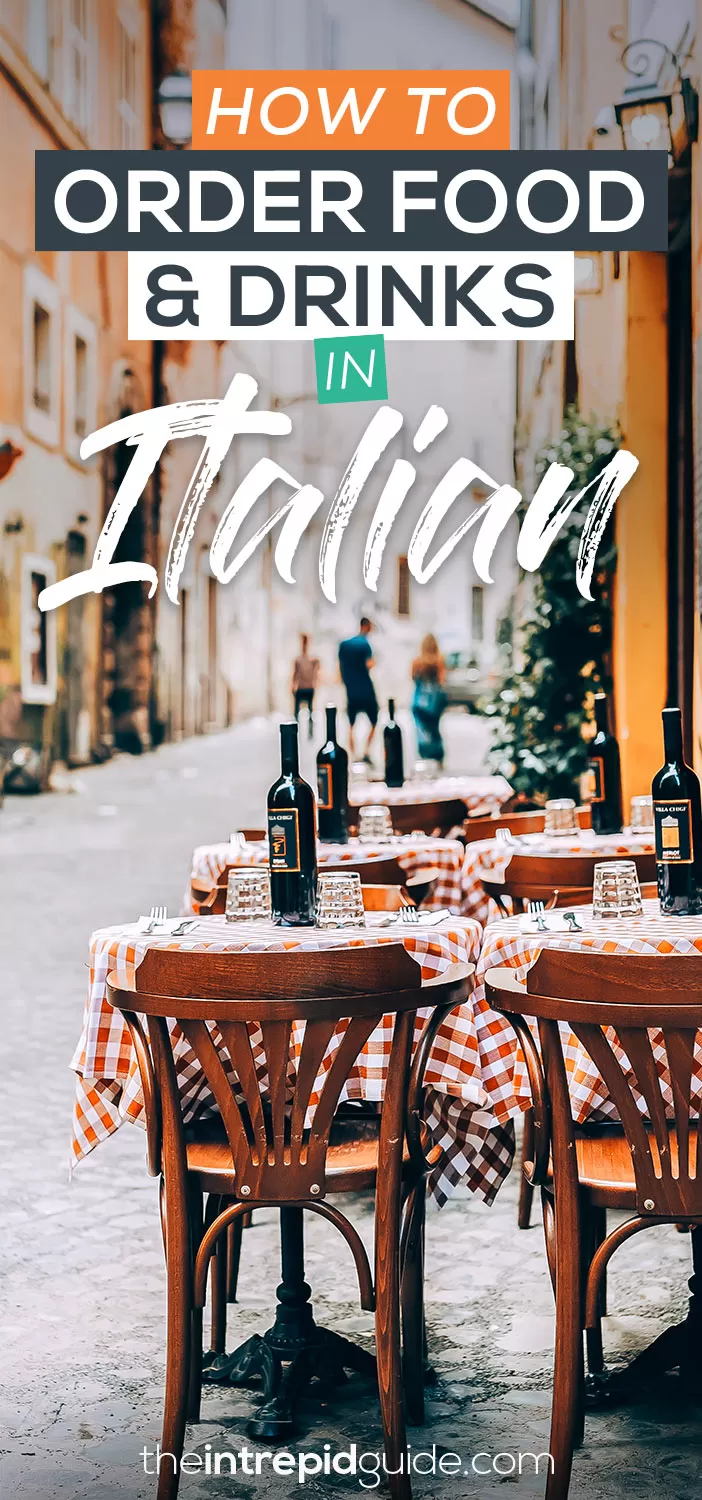
Over to you!
Do you have a question about ordering food and drink in Italian? Ask me below!
Let me know using the comments section below or join me on social media to start a conversation.
Thanks for reading and I hope you enjoyed this post.
Like what you see? Subscribe using the form below to have all of my posts delivered directly to your email.

